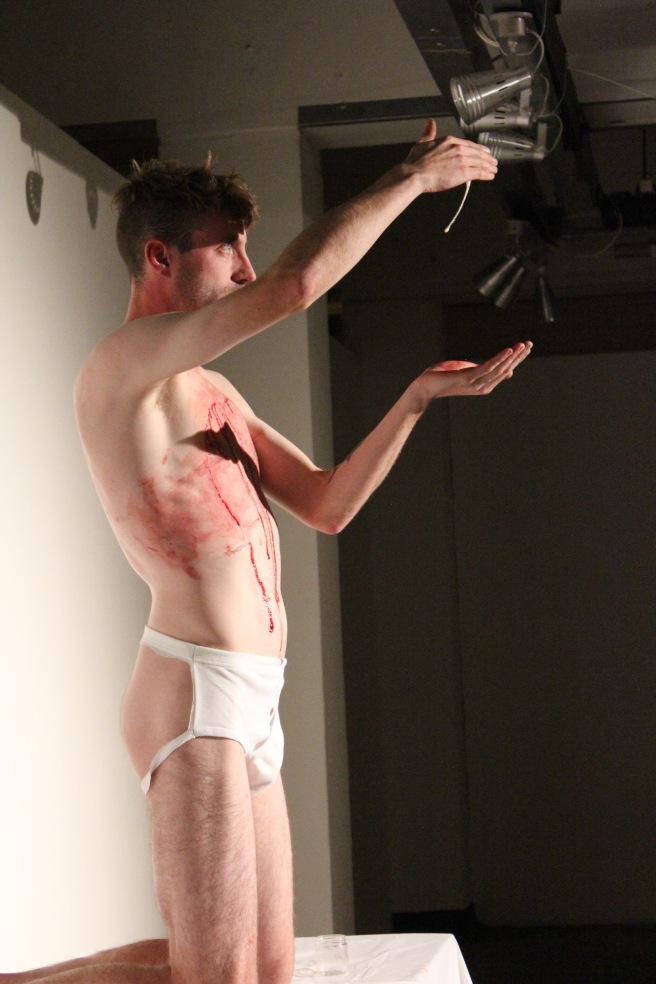By Dr. Kate Antosik-Parsons
Martin O’Brien’s two-hour intensely embodied live art work, It’s Good to Breath In (This Dublin Air), was performed at The Complex for the Dublin Live Art Festival (August 2017). Two large metal doors opened to reveal the artist seated atop metal stairs. Wearing a white jockstrap and a black PVC fetish mask with an expandable latex face piece, he took deep, controlled breaths, the translucent latex inflating when he exhaled. Alarmingly, the suction of breath inwards formed a seal over his mouth, his face temporarily arresting in a wordless scream. The recycling of oxygen in the mask and its tightness around his neck left his upper body flushed from the exertion. He descended the stairs and moved through the crowd, at times crawling. As he moved towards a small metal table that held various surgical implements and medical supplies, I wondered, with a mix of fascination and slight horror, how the performance would unfold.

O’Brien has Cystic Fibrosis, a chronic and fatal genetic disease of the mucus glands that affects the respiratory, digestive and reproductive systems and sweat glands.[1] It’s Good to Breath In (This Dublin Air) was based on series of actions that recalled the specifics of Cystic Fibrosis; coughing, shortness of breath, the expulsion of phlegm, stimulation of thirst and need to protect the body from infection. These engaged with his personal familial history, with its origins in Dublin, and his queer identity. The use of different latex masks and the performative self-mutilation body practices evoked pain, and, at times pleasure, associated with Cystic Fibrosis and the erotic, interpersonal role playing BDSM practices. O’Brien’s performance drew parallels with American performance artist Bob Flanagan (1952-1996) whose personal motto ‘fight sickness with sickness’ located his work in the intersections of Cystic Fibrosis and BDSM.[2]
The intensity and intimacy maintained throughout the performance was demanding for the viewer. After urinating into a metal bowl, O’Brien vigorously whisked warm piss with traces of bubble liquid from a small plastic bubble wand. Moving slowly and deliberately, he had a series of fascinating interactions with the crowd gathered as he blew piss bubbles at individual viewers. Each person encountered gauged their level of discomfort and indeed, engagement with this action. I stood opposite the artist and we shared an intense connection. His gaze challenged me, was he asking for my consent? By remaining still had I given it? He seemed aware of my uncertainty and smiled mischievously. As he pursed his lips to blow, I had but seconds to decide, would I allow his excretions to land on my face? The bubble released from the wand and gently floated towards me. Genuine laughter broke out as I cleverly avoided it using my own breath to blow it back towards him, the force of which caused it to pop in mid-air. As it burst it was symbolic of the fleetingness of breath.

The presence of the respiratory system, specifically the lungs, loomed throughout the performance, not only in the guise of the inhalation and expulsion of breath, but there were numerous allusions to their anatomical shape in the artist’s different actions. Cutting his skin with a scalpel, O’Brien traced the outline the organ onto the exterior of his body. Later, when he stood in a black trough cleansing himself and gargling with water mixed with urine, his body was lit from two spotlights that cast a double shadow behind him. Remarkably, it appeared to be a spectre of the lungs. Seated on the cold, concrete floor, he stuck white cotton balls to his chest in the outline of the lungs and trachea with white, tacky glue, it’s dripping, sticky qualities referenced both phlegm and male ejaculation. In the final part of the performance, and not coincidentally, one of its most compelling moments, O’Brien fit a flat, square makeshift device with a hole in the centre, reminiscent of a cock ring, around his scrotum and penis. Using needles, he splayed and pinned different parts of his flesh to its black background, manipulating his anatomy into the shape of the lungs. The frame around his genitalia provoked consideration of the ways in which sick bodies, like queer bodies, can be stigmatized and objectified. These disconcerting actions were both provocative and defiant as O’Brien sought to push his body, and the audience, to the limit, in turn highlighting the fragility of life and his struggle for survival.
Martin O’Brien performed It’s Good to Breath In (This Dublin Air) at the The Complex on 19 August 2017 as part of the Dublin Live Art Festival, curated by Niamh Murphy and Francis Fay. Photographs by Fiona Killeen (www.blueprintphotography.ie).
[1] Ireland has the highest incidences of Cystic Fibrosis with approximately 1 in 19 Irish people carrying one copy of the altered gene. https://www.cfireland.ie/about-cf/carrier-testing-for-cf
[2] Dominic Johnson, The Art of Living: An Oral History of Performance Art, Basingstoke: Palgrave Macmillan, 2015, p.115. Interestingly, O’Brien collaborated with Sheree Rose, Flanagan’s partner, on several performances between 2012 – 2016.
